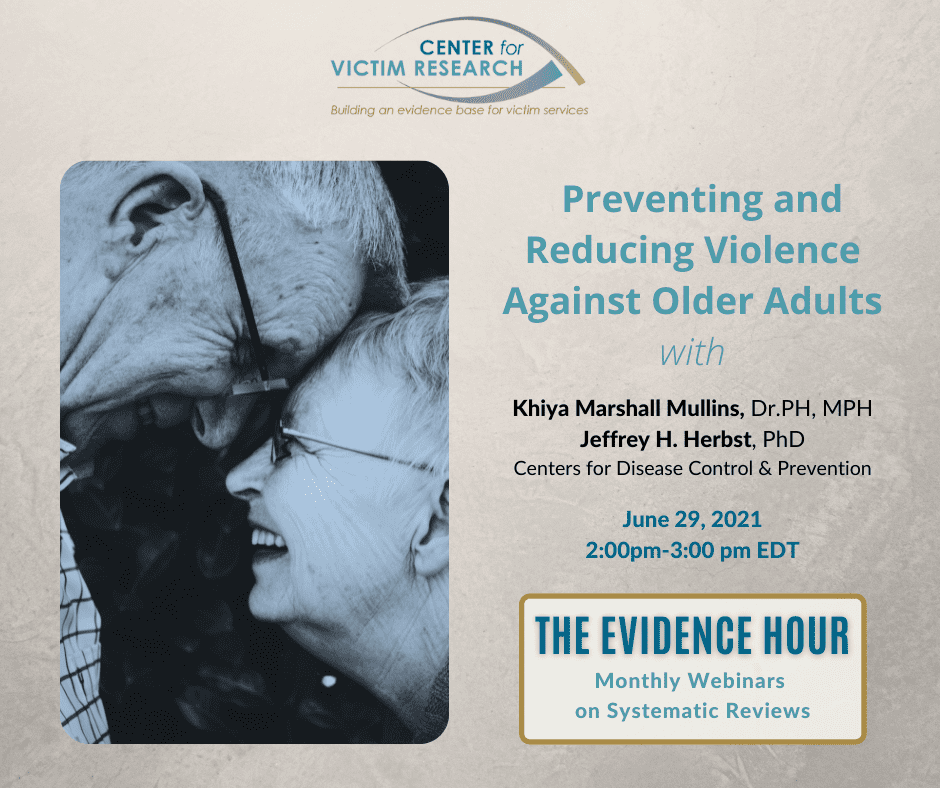The Evidence Hour: Preventing and Reducing Violence Against Older Adults

Center for Victim Research’s webinar series, The Evidence Hour, showcases a recent systematic review* or meta-analysis about victimization, trauma, or victim services. Each webinar features an author of the research and a practitioner discussant who will review the findings and reflect on what they mean for victim service providers and researchers.
On June 29, Drs.
Related Research from the Center for Victim Research:
Related Research on Elder Abuse Interventions:
- Adult Protective Services Training: A Brief Report on the State of the Nation by P. Liu & L. Ross (2021). Journal of Elder Abuse & Neglect. NAPSA developed a core training curriculum of twenty-three training modules covering four areas: orientation, supervised fieldwork, core competency training, and advanced/specialized training. This report summarizes online survey responses about APS training across the United States. Researchers found a wide variation across states about the training for provided for tenured employees and for new hires. The most commonly trained core competencies were APS Overview, Agency Standards, Abusive Relationships, and Intake, which were delivered in over 40 states. The most administered core competencies for new hires were the APS Overview, Agency Standards, Documentation, Intake, and Developmental Disability.
- Help-Seeking Behavior in Victims of Elder Abuse: A Systematic Review (Abstract) by S.F. Dominguez, J.E. Storey, & E. Glorney (2021) Trauma, Violence, & Abuse. Researchers conducted a systematic literature review on victims’ help-seeking behaviors. Based on the nineteen selected studies, the most common barriers to help-seeking was the victims’ fear of consequences for themselves or the perpetrators, feelings of shame, powerlessness, and dependency on the abuser, and lack of knowledge of services or their adequacy. Being a victim of financial abuse, being separated or divorced from the abuser, and having a poor mental health-related quality of life were associated with victims’ seeking help. Older adults sought help from health professionals, victim advocates, support groups, social workers, legal professionals, police, and local councils. [Contact the Librarian for full-text access]
- Identifying Interventions and Their Efficacy as Used by a Community Agency Managing and Responding to Elder Abuse by J.E. Storey, S. Hart, & M.R. Perka (2021). Journal of Applied Gerontology. Researchers reviewed a sample of elder abuse cases reported to a community agency. They examined the interventions used and their effectiveness. Practitioners used an average of seven interventions per case. Positive intervention outcomes were the most common (35%) and included novel or effective interventions aimed at perpetrators such as physical treatment, social support, and communication. Only 1% of interventions had negative outcomes.
Related Resources from our Research2Practice Network:
- National Resource Center for Reaching Victims: Increasing Access to Healing Services and Just Outcomes for Older African American Crime Survivors – A Toolkit for Enhancing Critical Knowledge and Informing Action within the Crim Victim Assistance Field (2020)
- Urban Institute: Assessment of Administrative Data on Elder Abuse, Mistreatment, and Neglect – Final Technical Report (2021)
- National Center on Elder Abuse: Intimate Partner Violence and Elder Abuse Among Older Native Americans during COVID-19 (2020); Mistreatment of Lesbian, Gay, Bisexual, and Transgender (LGBT) Elders (2020); and Mistreatment of African American Elders (2020).
*What are Systematic Reviews?
- A systematic review is the process of bringing together all available studies about a well-defined question, analyzing the quality of their study methods, and summarizing their findings.
- Systematic reviews often use a statistical practice called meta-analysis. This means combining data from multiple studies, to calculate the average effect of the intervention and find patterns.
- Because systematic reviews pool results from many experiments and rate the methods of each study, these reviews increase our confidence in the quality and consistency of the evidence and what it means for the field.
Basically, systematic reviews take a large amount of information about a complex issue from multiple sources and make that information more manageable and usable. These reviews can also help make sense of conflicting findings from different studies.
Learn more from:
- Quick Reference: Systematic Reviews
- Quick Reference: Tips on Reading Research Articles
« PREVIOUS NEXT »

Leave a Reply
You must be logged in to post a comment.